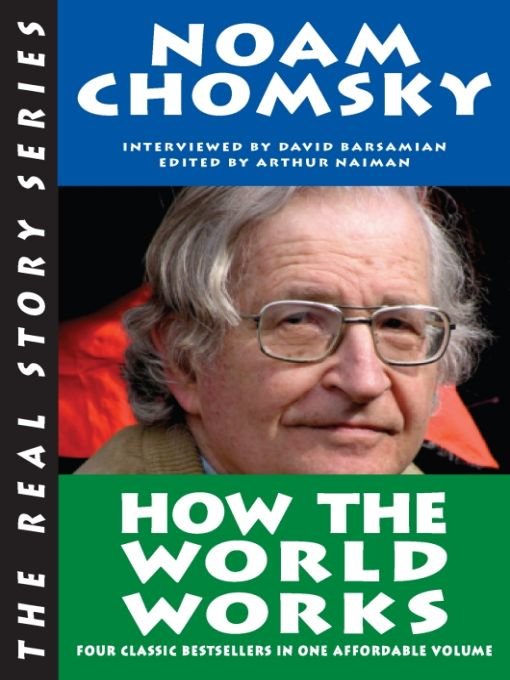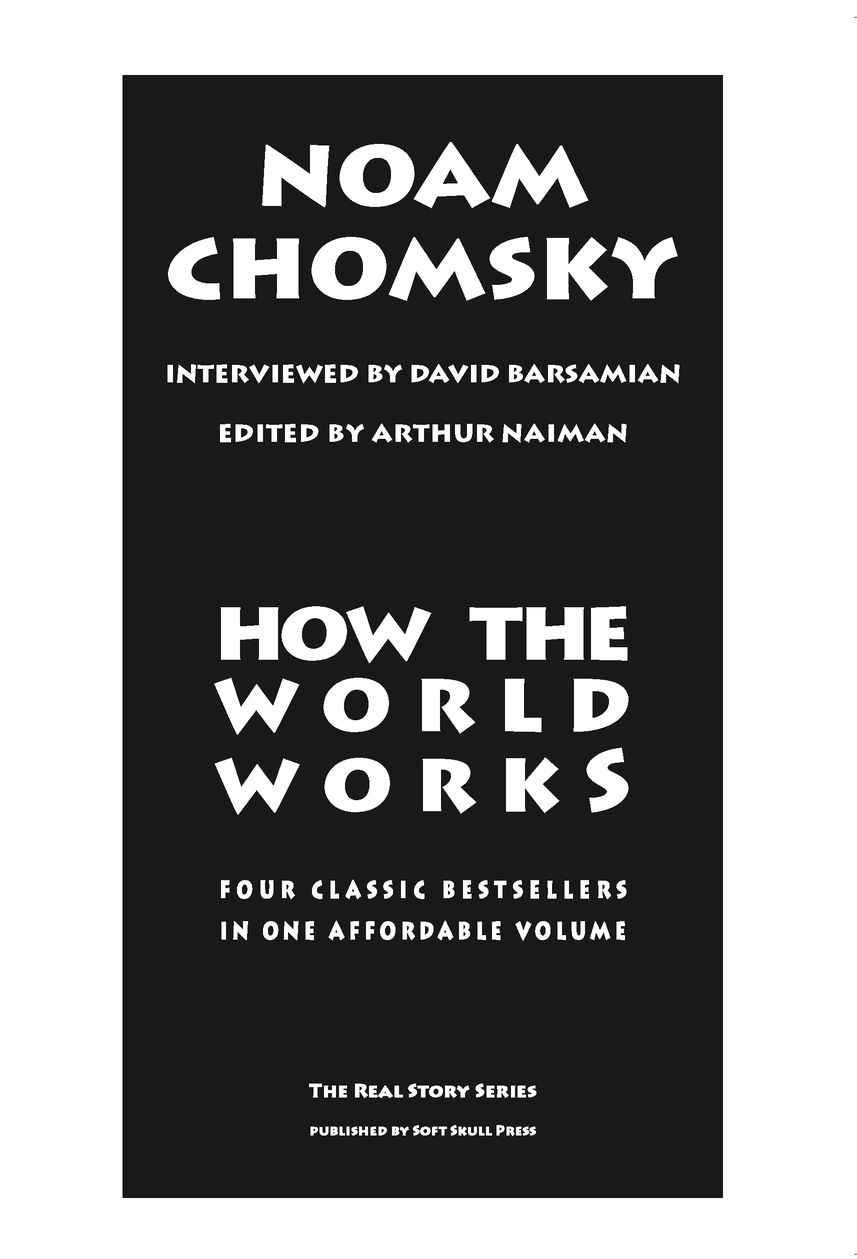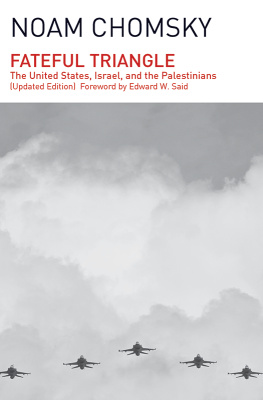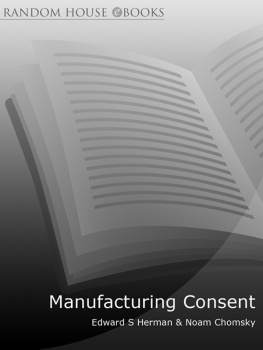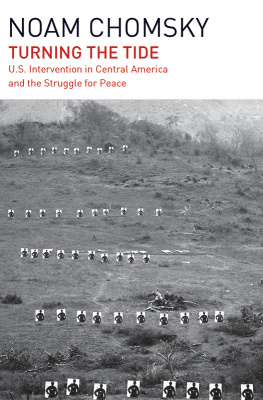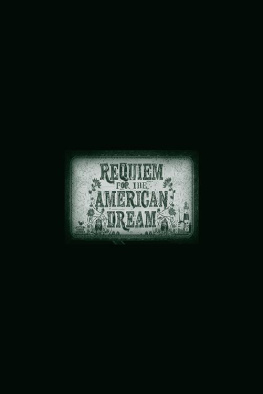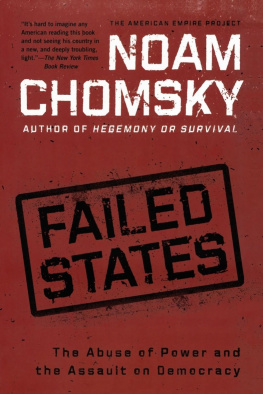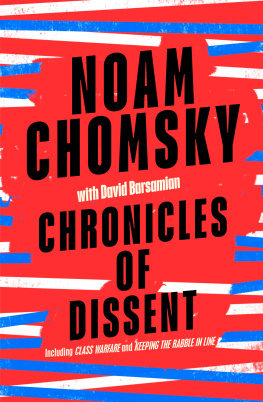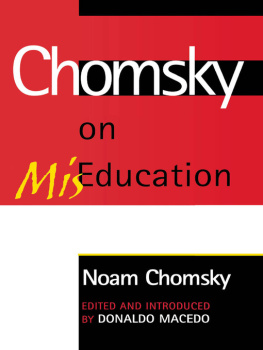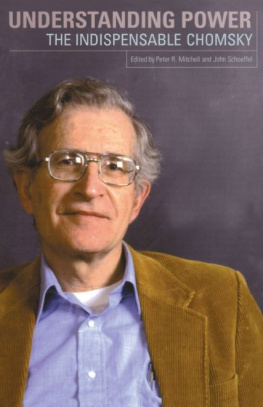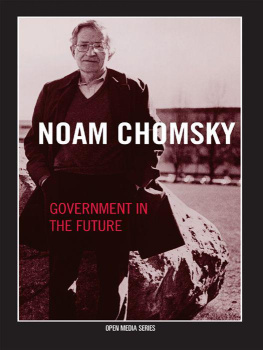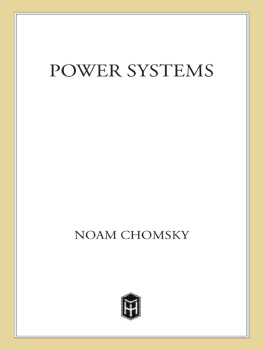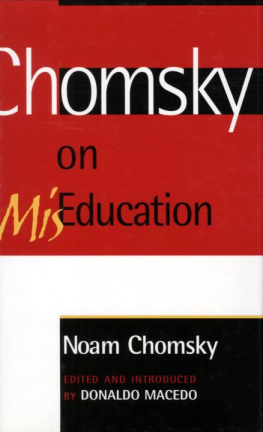Table of Contents
Interview questions and recordings:David Barsamian
Transcripts:David Barsamian, Sandy Adler
Compilation, reorganization, editing, copy-editing, inside design and layout, section heads, subheads, cover layout and copy:Arthur Naiman
Inital editing:Sandy Niemann
Copy-editing and proofreading: Julie Pinkerton, Susan McCallister, Suzanna Garland, Karen Bodding, Caitlin Far, John Kadyk, Sandy Niemann, Kimberly Ehart, Christine Carswell, Derek Stordahl
Index:Ty KoontzCover photo:Duncan Rawlinson
Book titles:Noam Chomsky, Charlie Winton, Susan McCallister, Arthur Naiman
Logistical support:Susan McCallister, Karen Bodding
Production coordinators:Julie Pinkerton, Caitlin Far
Moral support and emotional triage:Linda Spangler
Series editor:Arthur Naiman
Fonts:Bookmanmain text, subheads
Optimaquestions and misc. notes (like this one)
LIBERTYheaders, section heads, tables of contents
LITHOS BLACKcover, title pages, etc.
ABOUT THE AUTHOR
Noam Chomsky has long been the most cited living author; on the all-time list, hes eighth (after Marx, Lenin, Shakespeare, Aristotle, the Bible, Plato and Freud). Lionized abroad, hes by far the most important social critic in the world, but his political ideas are marginalized here in the United States. The modern-day equivalent of an Old Testament prophet, hes truly a prophet without honor in his own land.
The New York Times may grudgingly admit that hes arguably the most important intellectual alive, but they do it in the context of deploring his politics. Hes a media star in other countries and attracts standing-room-only audiences wherever he speaks here, but his appearances on American television are few and far between. The acceptable range of opinion stops long before it gets to him.
Yet the accuracy of his insights and his analyses is uncanny. In one of the classic books collected here, originally published in 1994, he warned: In 1970, about 90% of international capital was used for trade and long-term investmentmore or less productive thingsand 10% for speculation. By 1990, those figures had reversed.
We know where things went from there; it probably got to 99.9% speculation before it all came crashing down. Were paying now for not heeding him then (not that you and I had much control over it).
Heres what he said back in the 1990s about money lent to Third World goons, long before Western nations and international lenders like the World Bank and the IMF [the International Monetary Fund] began forgiving such loans:
As happened almost everywhere in the Third World, Brazils generals, their cronies and the super-rich borrowed huge amounts of money and sent much of it abroad. The need to pay off that debt is a stranglehold that prevents Brazil from doing anything to solve its problems; its what limits social spending and equitable, sustainable development.
But if I borrow money and send it to a Swiss bank, and then cant pay my creditors, is that your problem or mine? The people in the slums didnt borrow the money, nor did the landless workers.
In my view, its no more the debt of 90% of the people of Brazil than it is the man in the moons. Let the people who borrowed the money pay it back.
Fortunately, Brazil has advanced quite a bit from the sorry state it was in back thenthanks in no small part to Chomskys efforts on its behalf.
Avram Noam Chomsky was born December 7, 1928 in Philadelphia. His father William was a famous Hebrew scholar and Noam spent time on a kibbutz in his early twenties. The father of three children, he lost his wife Carol in 2008, after almost sixty years of marriage.
Since 1955 hes taught philosophy and linguisticsa field his theories have revolutionizedat MIT, where he became a full professor at the age of 32. In addition to his paradigm-shifting linguistic theories, hes written many books on political issues and has received countless honors and awards (including 37 honorary degrees). A nonstop activist with a relentless lecture schedule, he does more than any three normal people, but feels hes never doing enough,
Chomsky is an electrifying speaker, and thats due solely to what he says, not to the unpretentious, straightforward way in which he says it (he consciously avoids rhetorical flourishes). Sharp as a razor in debate but warm and amiable in conversation, hes both the most moral and the most knowledgable person Ive ever met.
I hope he lives to be 100. You should too. The world will be an emptier, lonelier and less just place without him.
Arthur Naiman
EDITORS NOTE
Made up of intensively edited speeches and interviews, this book offers something its not easy to findpure Chomsky, with every dazzling idea and penetrating insight intact, delivered in clear, accessible, reader-friendly prose.
The idea for what you have hereand for the Real Story Series in generalbegan when I heard a talk by Chomsky broadcast on KPFA radio in Berkeley. I was struck by how much more accessible I found his ideas when he spoke than when I read them, so I sent him a letter suggesting that I edit some of his talks together into a short, informal book.
He agreed and put me in touch with David Barsamian, who had been recording his speechesand conducting recorded interviews with himsince 1986. (Hes still at it).
Working from transcripts of seven talks and interviews that David provided, I spent several months grouping together all the different things Chomsky said at various times on a wide range of topics. I then picked what I thought were the best turns of phrase, removed the repetition thats inevitable when discussing the same subjects on widely separated dates, put everything back together so that it sounded coherent, and sent the result to Chomsky for final corrections. He supplemented my compilation of what he said with new, written material that amplified and clarified it.
We produced four books using this method: What Uncle Sam Really Wants; The Prosperous Few and the RestlessMany; Secrets, Lies and Democracy; and The Common Good. There was apparently a lot of demand for this new, conversational Chomsky, because the four books sold a total of 593,000 copies.
At the beginning of our three-way collaboration, I wasnt sure of the best way to present this material, so in the first book, I eliminated Davids questions entirely. They are, however, included in the other three books, where they appear in this typeface (as do phoned-in questions from radio listeners).
Each of the original books is presented here in the order in which it was published, with its own title page and table of contents. The index, however, was newly prepared for this volume and covers everything in it. (And I do mean everythingit isnt the sorry excuse for an index you find in most books.)
Ive tried to define terms and identify people you may be unfamiliar with the first time theyre mentioned. These explanatory notes appear in this typeface [inside square brackets]. If you run across a term or name you dont recognize, check its index entry for an italicized page number (which will usually be the first page on which the term appears).

